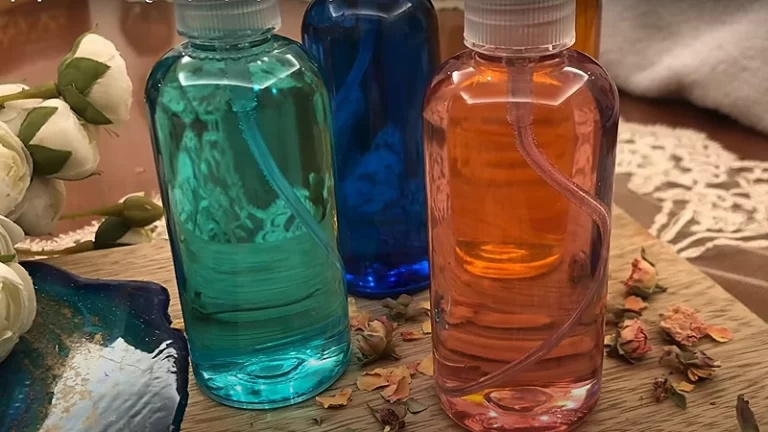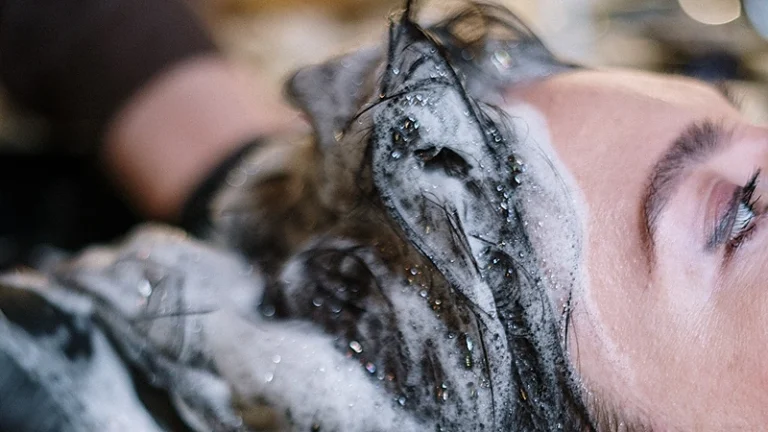Crafting Your Own DIY Shampoo with Natural Ingredients
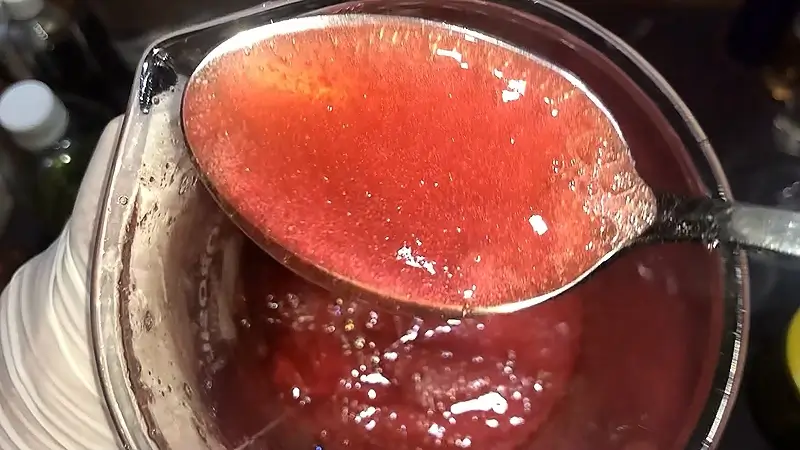
Author: Jinane Doughan
- Professional makeup artist with a degree from the French Fashion Institute ESMOD Dubai
- Specializes in natural skincare and haircare
- Accredited Master Trainer, offering workshops at a well-known academy with 16 branches
- Provides in-depth video courses on natural skincare and haircare through her private platform
- Shares expertise on her YouTube channel, Jinane World, with over 700 educational videos and 140K+ subscribers
Thank You!
Display ads support this website and its DIY content. I want to thank you for your patience with any inconvenience this may cause. I hope you discover valuable insights and joy as you explore!
Disclaimer
This article is for educational purposes only and is not medical advice. Always perform a patch test before using any natural skincare or haircare products.
Introducing our guide to crafting your own DIY shampoo with natural ingredients. In a world saturated with haircare products loaded with chemicals and additives, there’s a growing desire for a healthier alternative. Our recipe boasts a plethora of natural components, all meticulously selected to ensure your hair is pampered with the best nature has to offer.
Discover how this concoction of ingredients transforms into a chemical-free, wholesome haircare solution that will leave you with radiant and nourished locks.
Ingredients Needed
As you can see below, our DIY shampoo is packed with a whole bunch of ingredients. Don’t be alarmed. This is normal for a DIY shampoo crafted from scratch. The end result is a product that you will use many days a week and that is free from any harmful chemicals. Take your time assembling the ingredients!
Choose high-quality ingredients to boost the effectiveness and safety of your DIY beauty products.
- Rosemary hydrosol. Provides moisture and a refreshing scent to your shampoo.
- Distilled water
- Panthenol vitamin B5. Adds moisture and promotes hair strength and shine.
- Decyl glucoside. Acts as a gentle, natural surfactant to clean the hair. Surfactants are often used in things like shampoos to help the water and oils in the product blend smoothly, making it easier to clean your hair.
- Coco betaine. Enhances lather and foaming in the shampoo.
- Polysorbate 80. Helps mix oil and water-based ingredients.
- Grapeseed oil. Provides moisture and antioxidants for the hair.
- Fenugreek oil. Strengthens hair and promotes healthy growth.
- Black seed oil. Nourishes the scalp and helps maintain hair health.
- Rosemary carrier oil. Contains rosemary’s benefits and adds a pleasant aroma.
- Vegetable glycerine. Locks in moisture, preventing dryness in the hair.
- Xanthan gum. Thickens and stabilizes the shampoo’s texture.
- Mica color powder – Optional.
- Wheat germ protein. Strengthens hair strands and promotes vitality.
- Preservative germall plus. Extends the shelf life of the shampoo by preventing bacterial growth.
Tools Needed
- Scale to weigh quantities
- Large glass beaker
- Medium-size glass beaker
- Two small glass beakers
- Glass mixing rod
- Teaspoon
- Appropriate plastic bottle to store your DIY Shampoo with Natural Ingredients
Prior to use, ensure that both your utensils and containers are properly cleaned and disinfected. Wash them with warm soapy water, dry with a tissue, and then sanitize by spraying with 70% medical alcohol. Wipe them clean and let them air dry before use.
Steps: DIY Shampoo with Natural Ingredients
A- Preparing Decyl Glucoside/Coco Betaine
1- In a large glass beaker, pour 60 grams (2.11 oz) of rosemary hydrosol.
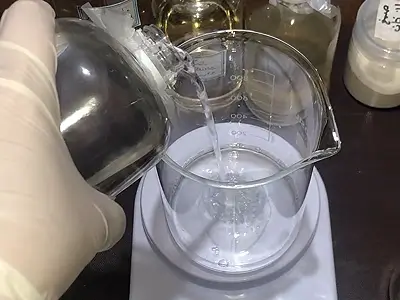
2- Add 95 grams (3.35 oz) of distilled water.
3- Add 3 grams (0.10 oz) of panthenol vitamin B5.
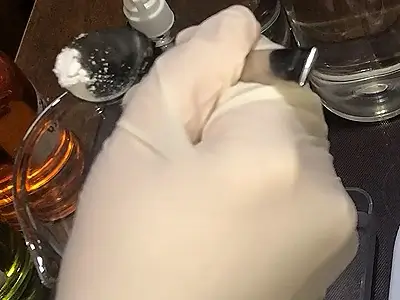
4- Mix thoroughly using the glass mixing rod.
5- Add 75 grams (2.64 oz) of decyl glucoside.
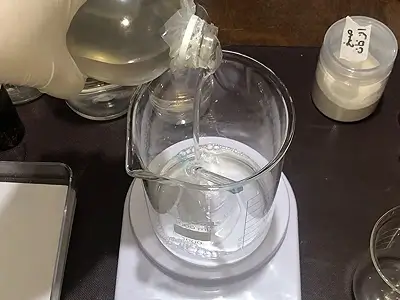
6- Add 45 grams (1.58 oz) of coco betaine.
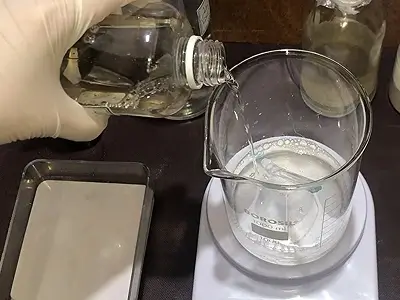
7- Using the glass mixing rod, stir the contents slowly and gently. Otherwise, you might get excessive foaming.
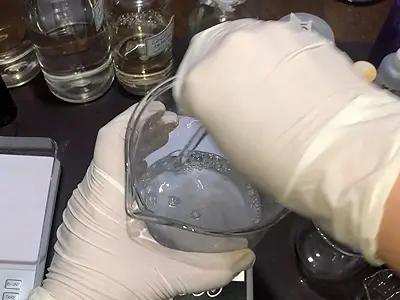
8- Leave the beaker aside for later use.
B- Preparing the Oils
9- In a separate small glass beaker, pour 5 grams (0.17 oz) of polysorbate 80.

10- Add 5 grams (0.17 oz) of grapeseed oil.
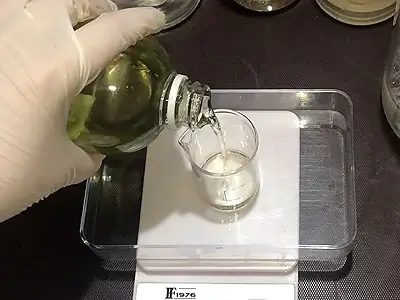
11- Add 2.5 grams (0.088 oz) of fenugreek oil.
12- Add 2.5 grams (0.088 oz) of black seed oil.
13- Add 5 grams (0.17 oz) of rosemary carrier oil.
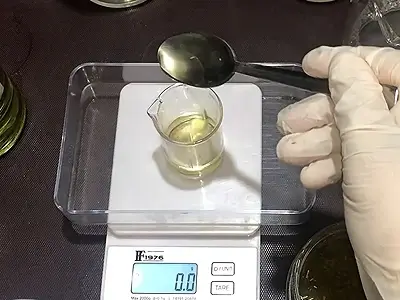
14- Stir the contents with a teaspoon.
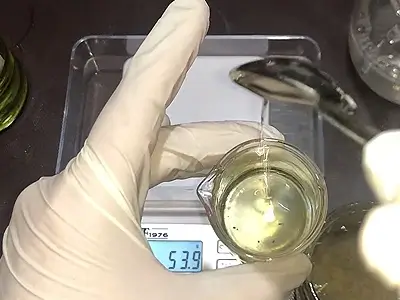
15- Leave the beaker aside. We will use the mixture soon.
C- Preparing Glycerine/Xanthan Gum
16- In another small glass beaker, pour 9 grams (0.31 oz) of vegetable glycerine.
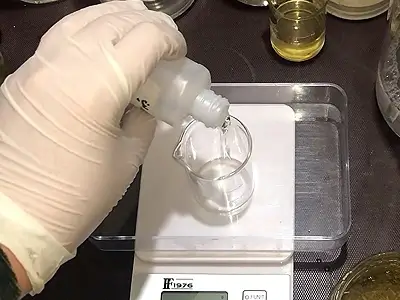
17- Add 2 grams (0.07 oz) of xanthan gum.
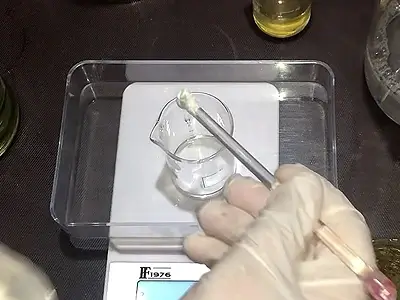
18- Mix rigorously with a clean mixing rod.
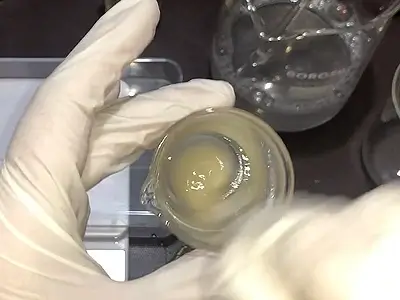
19- Optional – Add a small quantity of mica color powder. Choose a color you like.
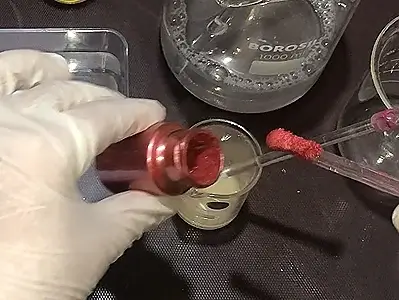
20- Mix the mica color powder thoroughly.
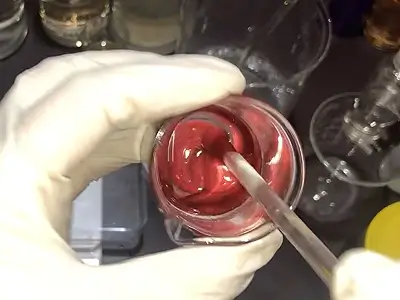
D- Finishing the Shampoo
21- While stirring, slowly pour the “glycerine/xanthan gum” mixture into the “decyl glucoside/coco betaine” mixture.
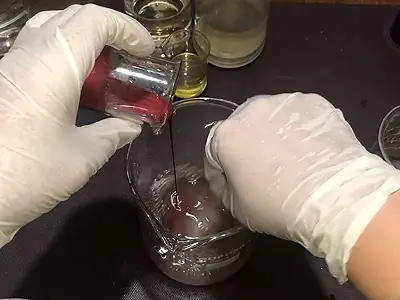
22- Continue stirring.
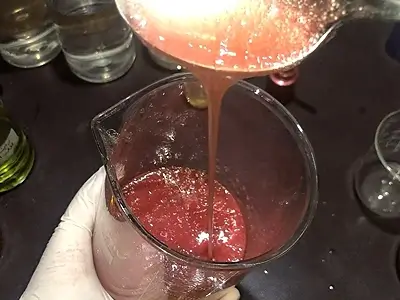
23- Add 3 grams (0.10 oz) of wheat germ protein.
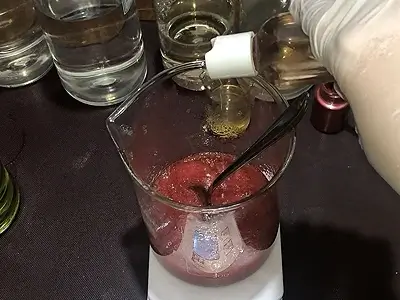
24- Add 1.5 grams (0.053 oz) of preservative germall plus.
25- Stir slowly but thoroughly the contents.
26- Pour the mixture of oils you prepared earlier into the shampoo mixture.
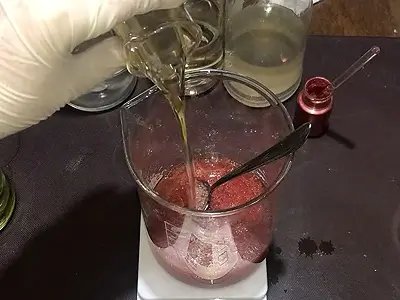
27- Give the contents a final slow stirring. If there is excess foaming on the surface, you can remove some with a spoon.
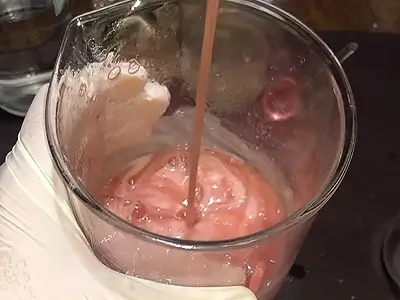
28- Leave the shampoo to settle for 24 hours.
29- After 24 hours, pour the DIY Shampoo with Natural Ingredients into an appropriate bottle.
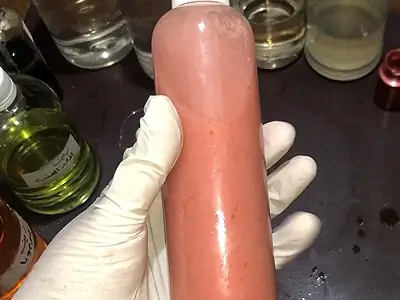
E- PH Acidity Test
It is important to check the PH of the DIY shampoo to ensure that the shampoo is good for use. The PH should be 4.5 to 6. The PH test kit I am using indicate colors corresponding to 5, 6 and 7. Using these colors is a sufficiently practical approximation.
30- Take a leaf from the PH test kit, and immerse it in the shampoo for about 15 seconds. Take it out, and wait 2-3 minutes. After that, compare the color of the leaf against the range of colors on the PH test kit. If you get a higher reading than the recommended range (as in my case in the image below; I got the matching color of 7), you have to bring the PH down:
- Simply, prepare a solution of 10 grams (0.35 oz) of distilled water and 10 grams (0.35 oz) of citric acid. Add 3 drops first to the shampoo, mix well, and re-test the PH. If required, add one drop at a time till the reading is in a good range.
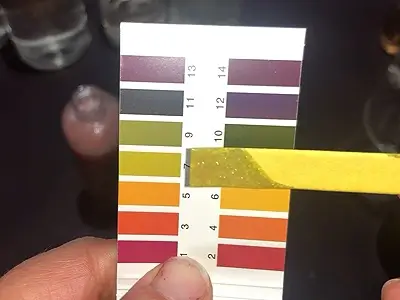
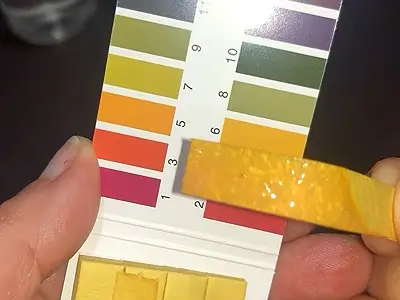
F- Let’s Try It Out
31- Pour a small quantity of the DIY shampoo in your palm.
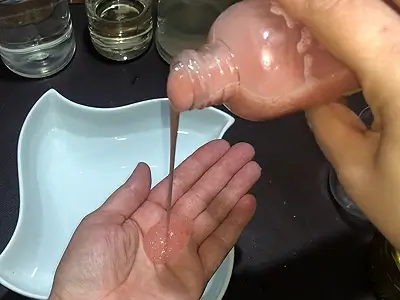
32- Add a little water and check the lathering.
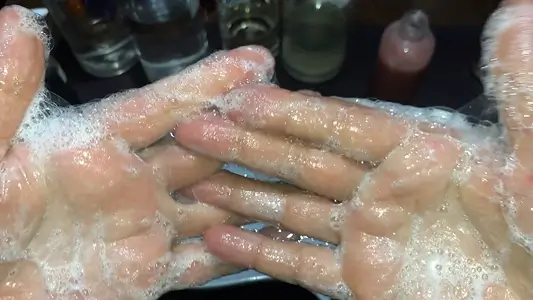
How to Use: DIY Shampoo with Natural Ingredients
To get the best results from your DIY Shampoo with Natural Ingredients, use it twice a week following these simple steps:
a. Wet your hair thoroughly with warm water.
b. Apply a small amount of the DIY shampoo to your scalp and hair. Massage gently to create a lather.
c. Let the shampoo sit for a minute or two. This allows the natural ingredients to work their magic.
d. Rinse your hair thoroughly with lukewarm water. Make sure there’s no shampoo left.
e. Follow up with your regular conditioner or a natural hair rinse if desired.
f. Enjoy the soft, refreshed feeling of your clean, chemical-free hair.
Simply repeat this routine twice a week for the best results and admire the healthy, beautiful locks you’ve nurtured.
Benefits
Here are the top 7 benefits of using your DIY Shampoo with Natural Ingredients:
Gentle Cleansing: Your DIY shampoo cleanses your hair and scalp without harsh chemicals, making it suitable for all hair types, even sensitive ones.
Nourishment: Natural ingredients like oils and panthenol provide essential nutrients, promoting healthy, vibrant hair.
Chemical-Free: Your shampoo is free from harmful additives, offering a natural alternative to commercial products.
Customizability: You have control over the ingredients, allowing you to tailor the shampoo to your specific hair needs.
Environmental Friendliness: By using natural ingredients, you reduce the environmental impact associated with synthetic chemicals.
Soothing Scents: Natural scents like rosemary offer a pleasing aroma during and after each wash.
Healthier, Shinier Hair: Regular use results in softer, shinier, and overall healthier hair.
These benefits make your DIY shampoo a fantastic choice for anyone looking to improve their haircare routine naturally.
Here are more articles on how to make natural haircare products:
- DIY Hair Toner with Fenugreek: Nourish, Lengthen, and Thicken Naturally
- Highly Moisturizing DIY Oat Milk Hair Cream: Care for Coarse and Unruly Hair
- DIY Hair Oil with Fenugreek: A Step-by-Step Guide for Longer and Thicker Hair
- Frizzy and Unmanageable Hair? Try DIY Natural Keratin for Hair Transformation
- Effective DIY Hair Treatment: Nourishing Oil Bath for Frizzy and Dry Hair
- Essential Nutrients for Hair Growth: 7 Powerful Tips to Know
Video How-To on My Channel | Jinane World
The steps to make the DIY Shampoo with Natural Ingredients are demonstrated in this video.


